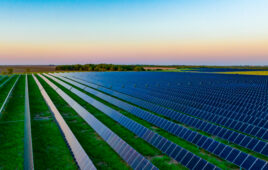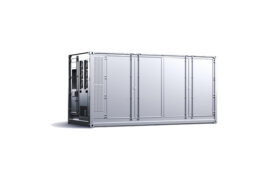The tariff on imported solar cells and panels will increase next year and bifacial solar panels will officially lose their exemption status, this according to a proclamation released over the weekend by President Trump.
The solar industry was the first market to feel the hit of tariffs brought on by Trump in 2018. Beginning in February 2018, imported crystalline silicon cells, modules and AC/integrated modules were tariffed 30% as part of a four-year outline. Imports received a 25% tariff in 2019, a 20% tariff in 2020 and were scheduled for a 15% tariff in 2021.
Various exemptions to the tariffs were allowed, mainly small-wattage off-grid panels, but bifacial modules were granted a full exemption in June 2019. Bifacial modules have been growing in popularity in the utility-scale solar market, and with no domestic manufacturers able to meet the demand, the tariff exemption was seen as a break to the price-conscious utility market.
After reviewing International Trade Commission reports and receiving a petition from “a majority of the representatives of the domestic industry,” President Trump this weekend proclaimed that domestic PV panel manufacturing is increasing. He also officially determined that the bifacial exemption was undermining the objectives of the original safeguard messages (which was to prop up U.S. solar manufacturing), so bifacial modules are back to being taxed. Within 15 days of the proclamation, bifacial imports will be taxed the full tariff amount.
And since bifacial imports were not tariffed for over a year, Trump will adjust the fourth-year rate of the overall tariff from 15% to 18%. The higher tariff rate will go into effect in February 2021.
The following is a statement on the proclamation by Abigail Ross Hopper, president and CEO of the Solar Energy Industries Association:
“The Trump administration decision this weekend to expand solar tariffs and evaluate an extension of those tariffs counters critical needs of our country right now, jeopardizing jobs, economic recovery in the face of a pandemic and a clean environment. Aspects of this policy may also run counter to law.
“Since the administration imposed solar tariffs, we have fought to delay the termination of the bifacial solar panel exemption. And we have suggested many, more constructive, ways to expand American manufacturing, including targeted tax policy and suggestions for growing the whole solar supply chain in a way that would meaningfully create jobs and fuel the economy. In addition, we published a white paper with ideas for boosting the U.S. solar manufacturing economy. It should not be lost on policy makers that last year the solar industry had 35,000 manufacturing jobs as part of nearly 250,000 total jobs. These jobs are being jeopardized by COVID-19 and tariffs across the supply chain.
“We are going to consider every option to reverse this harmful approach. We also will be talking with leaders in the next administration, regardless of who is president, about the harm of solar tariffs in the context of the COVID pandemic, a threatened economy and a critical need to address climate change.”





Wow
Thanks Trump. Seems
Like retaliatory moves as Oil/Gas/Fracking diminish.
This could drive costs and potentially stop some solar development
Trump doesn’t believe that Climate Change is a real problem and he said that he doesn’t think that “Scientists Know”.
Since he doesn’t “believe” the Science or Doctors you could talk to him but never convince
him.
He is lost to any reasoning.
It’s shocking!
But watt ya gonna do?
Oh well.
You are ” On the ball ” for news. I read all of your tweets. Keep it up your brilliant
Thank you!
“And since bifacial imports were not tariffed for over a year, Trump will adjust the fourth-year rate of the overall tariff from 15% to 18%. The higher tariff rate will go into effect in February 2021.”
This looks like “another” round in the appeals court. As the technology stirs the industry, there are “other” considerations than bifacial and “maybe” up to 20% more daily harvest of solar PV on any given day. For instance First Solar has been in business since 1999, it has successfully brought a thin film CdTe solar PV panel to market, but has efficiency that is 18% and CdTe has better light harvesting capabilities in hazy or cloudy environments. These panels take less energy to produce and have had a recycle program for old panels since 2003. How many “other” solar PV panel manufacturers have something like this? Especially in the utility scale solar PV farm, one can install large foot print, 27 square feet per 450 watt panel, and still come out ahead. These series 6 panels are also designed for utility scale at a nominal 221 or so VDC output. Makes strings easier to duplicate throughout the solar PV farm.
” He also officially determined that the bifacial exemption was undermining the objectives of the original safeguard messages (which was to prop up U.S. solar manufacturing), so bifacial modules are back to being taxed. Within 15 days of the proclamation, bifacial imports will be taxed the full tariff amount.”
I believe the amount of time living with the tariffs have proven statistically even (IF) a U.S. manufacturer falters and goes out of business, in the solar PV arena, you may lose 1,000 employees. When tariffs stifle solar PV installation throughout the industry one might see the effect of the loss of 10,000 or more solar PV installation jobs, 10 to 1 says get rid of the tariffs. From MY understanding, when one decreases taxes, then it drives commerce and make up for the loss of tax dollars with manufacturing output. So, far, it has been the experience there are 10,000 to 100,000 solar PV construction jobs idle with no tax base available at this time. When you shoot your own ideology in the foot with tariffs, there’s something missing in ‘some ones’ calculations.